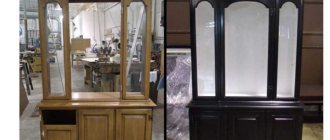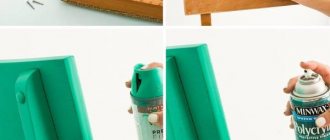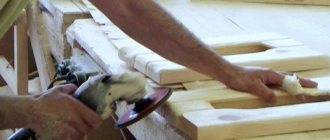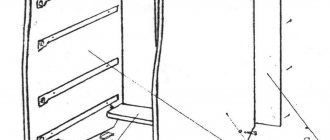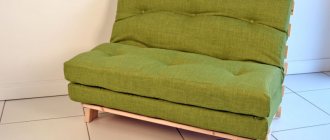Upholstery at Home (65+ Best DIY Ideas): Give Your Sofa New Life!
Reupholstering furniture is a great and easy way to update an old sofa without a significant financial investment!
Your upholstered furniture will serve faithfully for many more years, but its appearance is no longer entirely aesthetic? To correct the situation, it is enough to change the upholstery, which you can do yourself, saving on the services of furniture makers. We offer a simple algorithm and some useful tips that will help make the process of reupholstering a sofa or chair quick and productive.
The most popular option is reupholstering sofas with chenille
Accessories for sofas
Modern fittings will not only add functionality to your sofa, but also update its appearance. The most important mechanical element of the fittings for folding sofas is the transformation mechanism. When restoring a Soviet sofa with your own hands, it is recommended to change the transformation mechanism to a new one. If the old sofa has become difficult to unfold, then you can try to lubricate the moving elements of the mechanism with a special lubricant. If elements are broken or deformed, a new transformation mechanism will have to be installed.
The legs of the sofa can be equipped with furniture wheels if this piece of furniture is expected to be moved periodically. The wheels must be correctly selected according to the weight of the sofa. Otherwise they won't last long. Connecting elements should be replaced if necessary: corners, couplers, etc. Some sofas require drawers. You can change the guides: instead of roller ones, use ball ones, for example. Such a drawer will slide out smoothly and easily.
When might you need to reupholster your upholstered furniture?
During operation, upholstery material loses its attractiveness, brightness, smoothness, and possibly integrity. However, the furniture frame is still strong and reliable. It is irrational to purchase a new piece of furniture, because you can only change the upholstery.
It happens that the furniture is in almost perfect condition, but you have made repairs and the color scheme of the upholstery now does not fit into the interior. You may have been dreaming about a particular sofa model for a long time, but it comes in a modest range of colors. And changing the upholstery will help here.
The photo shows the process of simple and quick reupholstery of a kitchen chair
Unusual knitted sofa upholstery in the living room
A clear example of giving a chair a second life
In what cases can you not do without the help of professionals?
- If the product's service life exceeds 5 years. Surely, in addition to worn out upholstery, there is damage to frame elements. When reupholstering furniture, all defects must be corrected, and you may not have the necessary tools or spare parts at hand.
An interesting non-standard sofa design requires the hand of a professional
Upholstery of an upholstered chair in leather
- If you are going to reupholster furniture with leather or leatherette. This is a difficult material to work with, and it is not always possible to do quality work at home.
Classic sofa in a new velor “wrapper”
We disassemble furniture for reupholstery
The reupholstery process begins with the stage of disassembling the furniture product into individual parts. Here the procedure depends on the configuration of the furniture. Typically, the armrests (if any) are removed first, then the backrest and mattress. You will most likely need several screwdrivers of different sizes.
Advice! Place all fastening fittings in a pre-designated container so that during assembly you do not encounter the problem of a lack of fasteners. Number all the parts and sketch out a diagram on paper so that later you will know exactly how to assemble it.
If the furniture has antique value, it simply needs to be brought into proper shape.
Retro-style armchair upholstered in various pastel-colored fabric scraps
Advice! Record the disassembly process on video or make a photo report - this way you will receive clear instructions for assembly.
Pros and cons of DIY furniture restoration
Before you begin restoring any piece of furniture, it is worth assessing the advantages and disadvantages of doing the work yourself. Let's figure it out - should you do it yourself, or entrust the restoration to a professional furniture maker?
A simple restoration can be done quickly and efficiently yourself
Advantages of doing the work yourself:
- Saving money. Firstly, you don’t have to pay a restorer for the work, and secondly, to deliver the furniture to the workshop, you may need the services of loaders and a truck.
- Possibility of control. You independently purchase all the necessary materials for furniture repair, and have the opportunity to carry out each stage of the work exactly according to the instructions, thereby obtaining a better result.
- Realization of your own ideas. The furniture will look exactly the way you want. If you wish, you can change or supplement the progress of work without coordinating the adjustments with anyone. So, it may seem to you that the resulting paint shade is not the best and the furniture needs to be repainted, whereas once you receive the furniture from the workshop, you will not be able to change anything.
Disadvantages of home restoration:
- Recreating the original shape of furniture, coverings or complex elements is best left to a professional craftsman. A beginner does not know many of the nuances, and when doing complex work for the first time, you may not guess correctly and ruin the furniture forever.
- Saving effort and time. Having handed over the furniture to a restoration workshop, you forget about it for a while, and then accept the finished result. If you do the repair or restoration of furniture yourself, then you will have to work on weekends or in the evenings - during the time allotted for rest. It may suddenly turn out that work will be a burden to you.
- Lack of space to work. When restoring furniture, you will certainly encounter wood dust in your apartment, the smell of various chemical compounds, and cluttered space. If possible, work should be carried out in a non-residential space - in a garage, on a loggia, in the warm season - on the street.
Disposable protective covers for furniture can be purchased at hardware stores.
Removing upholstery from upholstered furniture (step by step)
To do this, use a flat screwdriver to lift the staples that secure the upholstery material, and then use wire cutters to remove the staples. We work carefully so as not to damage the upholstery - it will come in handy later.
Even if the chair did not have a soft back, you can create one
A hot pink velor ottoman creates a dreamy atmosphere in a darkened room
Advice! Before starting work, lay plastic or newspaper on the floor. The fact is that when removing the upholstery from old furniture, crumbled foam rubber and various debris will fall out.
Bright woolen fabric on an antique sofa with a wooden base
Carriage furniture reupholstery
Where to start reupholstering furniture
Of course, you can invite a furniture specialist who will repair the sofa or armchair, or you can do the work yourself. We will try to cover the topic “how to reupholster furniture with your own hands”, what to pay attention to, where to start the process and in which case you should not carry out repair work on furniture yourself.
Despite the fact that the method used by specialists differs from the method of upholstery at home, the result will be no worse, but more interesting, if you try. A low budget will also be a plus, because you will only have to spend money on material and tools, which you will have in the future.
The result will be excellent if:
- disassembling the furniture did not cause you any difficulty;
- the furniture has not lost its shape in terms of the frame, because it is difficult to change the structure, you need to have experience;
- your furniture is not antique, it is more difficult to work with such a product, it requires a thrifty and special approach;
- The sofa or chair should be upholstered with barracks or other upholstery material, but not with leather or its substitute.
The remaining cases are not as difficult as it seems, at least the task is doable even for a non-professional.
Steps for upholstering a sofa with new material:
- analysis of product elements - poufs, armrests, sides and pillows;
- eliminating worn upholstery;
- determining product dimensions and cutting new upholstery;
- fixing fabric to dismountable furniture parts;
- final assembly of the furniture structure.
DIY sofa reupholstery technology
The first step is to capture your sofa in a photo so that you can understand what the structure originally looked like before disassembly. Since not everyone can remember the details of the entire furniture structure.
Disassembly of furniture into details
As stated above, it is necessary to decompose the sofa into parts, that is, disassemble it. To do this, disconnect the sides without damaging the fastenings, remove the overhead elements, seat, backrest, pillows, poufs, if any.
Place the fasteners in a separate box or bag so as not to lose them.
Removing worn textile upholstery
Stock up on tools such as a screwdriver or anti-staple gun to remove the mounting brackets. Carry out the work of removing the barrack carefully so as not to damage the coating; it will still be useful for making patterns from new textiles.
Expert opinion
Smirnova Ekaterina Anatolevna
7 years of experience in interior design, professional architect
After cleaning the material from dust and dirt, it can be reused if it has not lost its original appearance. Foam rubber, which most often serves as a filler in upholstered furniture, is best replaced if it is rotten.
By replacing the old foam rubber with a new one, you will update not only the appearance of the sofa, but also the quality of the surface; it will be elastic, dense and meet the needs of the furniture owner. After all, with old foam rubber, dents, lumps and irregularities will disappear.
Under the filler, the structure consists of springs, metal mesh, rubber belts, nylon guy wires or wooden slats. If they are defective, they need to be replaced or repaired.
Cut out new upholstery
Making a pattern is one of the important stages in reupholstering furniture; the result depends on the correctness of the actions. You can simplify the task if you use old upholstery material that was removed from the furniture. Before cutting out the pattern, add a few centimeters to the pattern mark along the edges for an allowance.
The material for upholstery of upholstered furniture should be functional and practical. If the sofa will be used as a bed, then the material should be selected as environmentally friendly and breathable.
But if guests will gather on the sofa and it will play the role of a seat, then choose upholstery fabric that is wear-resistant, durable, non-marking, and with synthetic fibers.
Attaching fabric to structure
We stretch the finished fabric over the part, fix it along the edges, tucking in the excess on all sides, and use construction staples or shaped furniture nails to fix the fabric along the edge on the back surface of the structure. Please note that the fabric should be evenly and tightly stretched so that the pattern on the front of the barrack does not become distorted.
Excess fabric can be used to decorate poufs, chairs, benches, which will look harmonious with the rest of the furniture. You can also use the cuts to create decorative and designer pillows.
Assembling furniture after reupholstery
The photo you took at the initial stage of renovation will play an important role in assembling the furniture. You can connect the elements of upholstered furniture using these photos to make sure everything is done in the correct order. Below we have added a video on how to reupholster furniture with new upholstery fabric, replacing the old surface.
Cutting out upholstery material
This is where the old upholstery comes in handy - we use it as a pattern. When cutting, make additional allowances - 1-2 cm, so that it will be easier for you, as a non-professional, to install the material.
Important! When purchasing upholstery fabric, always take extra. If during the process you find that there is not enough fabric, it is not a fact that the store still has it. Perhaps they brought in a different batch and the shade differs by several tones.
The process of reupholstering a chair seat
Advice! If you bought much more fabric than you used, sew additional decorative elements from it - sofa cushions, lampshades. This way you will create a harmonious and stylish interior.
Additional accessories made from fabric scraps
Upholstering furniture parts
Before stretching the fabric, you need to carefully prepare the base. Be sure to lay padding polyester, batting or interlining on top of the foam rubber or “sandwich” with a spring block. This gasket will protect the upholstery fabric from abrasion from the inside, facilitate the process of tensioning the upholstery and extend its service life.
Advice! If you use a fairly thick layer of synthetic padding, the furniture will be noticeably softer.
Calfskin upholstery on a high chair in Provence style
You need to pull the material carefully, and it’s good if you have an assistant. The fabric should be stretched equally in all places, on all sides and in every direction. Then the product will look neat, the upholstery will not deform over time. The easiest way to secure the upholstery is with a furniture stapler, but you can also do it the old fashioned way - using nails and a hammer.
Advice! In places where you need to sew fragments of upholstery material, use special threads for furniture fabrics - they are stronger and more durable than simple sewing threads.
Materials and tools
In order to remake the sofa, the girl needed very little:
- upholstery fabric;
- construction stapler;
- needle;
- threads (color corresponding to the shade of the upholstery material).
First we needed to disconnect the armrests. The main part of the sofa had to be covered with a solid sheet of material. Using a stapler, the upholstery was attached to the base of the sofa.
The armrests were covered in the same way. Since the sofa has a rather streamlined shape, additional hand stitching was required in some places. After the work was done, it was necessary to simply connect all the parts back together.
Upholstery of furniture at home: choice of fabric and photos of finished products
The fabric base with fine pile glued onto it is flock, a popular upholstery fabric. Flock has high decorative properties and a wide range of colors; it is soft and easy to clean.
Interesting! To prevent flock from abrasion, it is coated with Teflon, this material is called courtesan.
Colorful colorful flock for furniture upholstery
Choice of upholstery material
When choosing fabric, it is not enough just to decide on the color and pattern depicted on the canvas. It is very important to know the characteristics of the fabric that will be used to cover the sofa. Let's look at some furniture fabric options.
- Matting. Inexpensive and affordable option for furniture fabric. The fabric is quite durable and not prone to stretching. Most often there are single-color options, but there is a matting with spraying. The material is easily cleaned from contaminants due to the synthetic components in the structure.
- Velours. Quite expensive material. It has a high level of strength and resistance to dirt. The surface of the velor resembles velvet; the pile can be positioned vertically.
- Jacquard. This material is often used in the manufacture of furniture. Jacquard is a very durable and wear-resistant material that cannot be deformed. The fabric usually has a pattern that is embroidered with threads of different colors. If you have a cat in your house who likes to sharpen its claws on furniture, then this fabric will be the best option for upholstering a sofa.
- Chenille. Durable and wear-resistant material. You can choose a model that will be resistant to animal claws. The material is easy to clean and does not stretch. The cost is affordable for the average Russian citizen.
- Flock. The base fabric is made using cotton and polyester, after which pile is applied to the surface using an electrostatic method. The fabric is soft and rough to the touch. High strength and resistance to deformation are very important parameters when choosing a fabric; flock has both of these qualities. The material is easy to wash.
Velours
Beautiful velor is sometimes called furniture velvet because of its high decorative properties. This material is practical and wear-resistant, but shrinkage, lint loss, and abrasion are possible during active use.
Chenille
Fluffy, soft and inexpensive chenille is in many ways not inferior to velor, and in some ways even superior to it. Chenille is not subject to shrinkage, pellets or “bald patches” do not form on the surface, the pile does not wrinkle, the fabric does not burn or rot.
Simple, but at the same time practical chenille will last for many years
Unusual bright colors of the sofa in an eclectic style
Microfiber
The most practical upholstery would be microfiber. The fabric has dust-repellent properties and is resistant to stains. Microfiber is easy to wash, does not change color and is not deformed. The only drawback is the impressive price.
Rich shades of jacquard on an antique sofa
Transform an old, boring piece of furniture into a brand new and stylish furniture masterpiece! By doing your own upholstery, you'll save money and learn new skills.
Source
Peculiarities
You can reupholster a sofa of any shape and size, and this work can be done either independently or with the help of specialists in a furniture workshop. If you perform the reupholstery yourself, it is worth remembering that such a process has some features that you will definitely have to encounter during the work.
First of all, you will have to independently take care of choosing and purchasing not only suitable material, but also a sufficient quantity of it. So, for a leather sofa, it is better to purchase eco-leather rather than genuine leather as an upholstery material, and the material should always be taken with a reserve.
Not only the appearance of the restored furniture, but also its subsequent service life will depend on the correct choice of fabric.
It is imperative to take into account the design features of a particular furniture model. Some sofas have a rather complex shape and cannot be completely disassembled when replacing the upholstery, so you will have to try to ensure that in such places the fabric completely follows the shape of the sofa itself. So, when reupholstering a corner sofa, you need to pay special attention to the degree of tension of the fabric at the corners and joints of the parts of the frame of this furniture. There may be some difficulties in performing this work without the proper skills.
The second feature is that if the furniture is too old and not only the upholstery fabric itself has worn out, when reupholstering it will be necessary to replace not only the material, but also part of the filling in the furniture, and possibly some parts of the frame.
This should be taken care of in advance.
By reupholstering sofas at home, you can not only extend the life of the furniture itself, but also visually change its appearance, and with it the room itself. After all, many people know that the overall tone of the interior style of a room is set by the furniture that is located in it. Therefore, the restoration process itself must be approached very seriously. During the work itself, you should not rush and be distracted by foreign objects. It is best to do the sheathing at a time when no one and nothing can disturb you.
You need to be prepared in advance for the fact that the work itself, especially when done for the first time, will take quite a lot of your time and effort.
By and large, you can upholster any sofa at home with your own hands, regardless of its size. The main thing is to stock up on all the necessary materials and tools in advance, carefully study the instructions for performing this work and be ready to follow them completely. If such work seems quite labor-intensive, then you can practice on a chair or armchair, or even entrust the upholstery to specialists.
How to reupholster a sofa with your own hands, step by step instructions
The upholstery of upholstered furniture after long-term use becomes unusable or indecent, losing its former attractiveness. Sometimes you just want to change the upholstery because it doesn’t match the interior of the room. There is no need to rush into replacing furniture; you can simply think through the design and change the upholstery material.
Where to start reupholstering furniture
Of course, you can invite a furniture specialist who will repair the sofa or armchair, or you can do the work yourself.
We will try to cover the topic “how to reupholster furniture with your own hands”, what to pay attention to, where to start the process and in which case you should not carry out repair work on furniture yourself. Despite the fact that the method used by specialists differs from the method of upholstery at home, the result will be no worse, but more interesting, if you try
A low budget will also be a plus, because you will only have to spend money on materials and tools, which you will have in the future
Despite the fact that the method used by specialists differs from the method of upholstery at home, the result will be no worse, but more interesting, if you try. A low budget will also be a plus, because you will only have to spend money on material and tools, which you will have in the future.
The result will be excellent if:
- disassembling the furniture did not cause you any difficulty;
- the furniture has not lost its shape in terms of the frame, because it is difficult to change the structure, you need to have experience;
- your furniture is not antique, it is more difficult to work with such a product, it requires a thrifty and special approach;
- The sofa or chair should be upholstered with barracks or other upholstery material, but not with leather or its substitute.
The remaining cases are not as difficult as it seems, at least the task is doable even for a non-professional.
Steps for upholstering a sofa with new material:
- analysis of product elements - poufs, armrests, sides and pillows;
- eliminating worn upholstery;
- determining product dimensions and cutting new upholstery;
- fixing fabric to dismountable furniture parts;
- final assembly of the furniture structure.
DIY sofa reupholstery technology
The first step is to capture your sofa in a photo so that you can understand what the structure originally looked like before disassembly. Since not everyone can remember the details of the entire furniture structure.
Removing worn textile upholstery
Stock up on tools such as a screwdriver or anti-staple gun to remove the mounting brackets. Carry out the work of removing the barrack carefully so as not to damage the coating; it will still be useful for making patterns from new textiles.
After cleaning the material from dust and dirt, it can be reused if it has not lost its original appearance. Foam rubber, which most often serves as a filler in upholstered furniture, is best replaced if it is rotten. By replacing the old foam rubber with a new one, you will update not only the appearance of the sofa, but also the quality of the surface; it will be elastic, dense and meet the needs of the furniture owner. After all, with old foam rubber, dents, lumps and irregularities will disappear.
Cut out new upholstery
Making a pattern is one of the important stages in reupholstering furniture; the result depends on the correctness of the actions. You can simplify the task if you use old upholstery material that was removed from the furniture. Before cutting out the pattern, add a few centimeters to the pattern mark along the edges for an allowance.
The material for upholstery of upholstered furniture should be functional and practical. If the sofa will be used as a bed, then the material should be selected as environmentally friendly and breathable. But if guests will gather on the sofa and it will play the role of a seat, then choose upholstery fabric that is wear-resistant, durable, non-marking, and with synthetic fibers.
Attaching fabric to structure
We stretch the finished fabric over the part, fix it along the edges, tucking in the excess on all sides, and use construction staples or shaped furniture nails to fix the fabric along the edge on the back surface of the structure. Please note that the fabric should be evenly and tightly stretched so that the pattern on the front of the barrack does not become distorted. Excess fabric can be used to decorate poufs, chairs, benches, which will look harmonious with the rest of the furniture. You can also use the cuts to create decorative and designer pillows.
Material selection
In any case, regardless of whether the work of reupholstery is carried out independently or by specialists, the first thing you will have to face is the choice of a suitable material. Experienced professionals recommend using the following tips in this case:
- is imperative to change the soft filling of the sofa , and not just its upper fabric. If padding polyester is used as a filler, then preference should be given to one that has a pure white color, as this is evidence of its high quality. If the filler is foam rubber, then you need to use two sheets of it, 2 cm thick, and lay a sheet of felt between them.
- For the upper upholstery material, it is better to choose a dense fabric that has a small pattern without large or voluminous prints. This will allow you to save on material, because pieces of it will not fall back due to a mismatch in the pattern. In addition, as practice shows, such sofas get dirty less and retain their appearance better during use.
- It is better to give preference to fabrics that do not have lint, for example, leatherette . If there are villi, you need to ensure that they are short and of the same length. Please note that the fabric does not have a sharp and strong unpleasant synthetic aroma. If it exists, then this indicates low quality and its unsuitability as a fabric for furniture restoration.
- It is better to abandon too rough materials and replace them with eco-leather or tapestry, which will give the furniture a refined, beautiful and stylish appearance. The word “rough” means fabric that is unpleasant to the touch and has an unpresentable appearance. Using such material, you can not update your furniture, but, on the contrary, artificially age it even more.
Preparatory stage
Once the required material has been selected, you can proceed to the first stage of upholstering the sofa, which consists of creating a pattern from the fabric. This stage should be given special attention, because the result of the entire final work will depend on the quality of its implementation. In this case, the pattern can be made in two different ways:
- Make a pattern based on the old upholstery , which was previously removed from the sofa. In this case, the removed upholstery is applied to the purchased fabric and traced along the contour. Be sure to leave an overlap of a few centimeters - 5 will be enough. Subsequently, the resulting pattern is applied to the furniture frame and if it matches its contours, it is cut out.
- The second option is more labor-intensive. First, all parts that can be removed are removed from the sofa - armrests, backrests and pillows, carefully measured with a tape measure on all sides, and the results obtained are transferred to the fabric, taking into account the addition of 5 cm on each side. Subsequently, all parts of the pattern are cut out and applied to suitable places on the sofa . If everything is in order and the pattern pieces are the required size, you can proceed to further steps.
When creating a pattern using any of the methods described above, experts recommend double-checking the measurements taken correctly before cutting the pattern from the fabric. It is in this situation that the proverb “measure twice, cut once” is more relevant than ever.
Photos before and after
A well-chosen shade of finishing material played an important role. This season it is a very fashionable color. The sofa began to look more modern.
Considering that the upholstery was made by hand, we can safely say that this sofa is a unique design solution. The great thing about this kind of remodeling is that you can independently select the color of the sofa to suit a specific interior. If necessary, it will not be difficult to change the fabric to a newer one. Perhaps even regularly redo the sofa, changing not only the color, but also the texture of the fabric. So one piece of furniture can be reincarnated several times, complementing the space of the room and transforming it.
Found a violation? Report content
Required Tools
In order to reupholster a sofa at home, as well as to complete its preparatory stage - creating a pattern, you may need the following tools:
- The material of the upholstery itself.
- Filler material.
- Scissors.
- Chalk or bar of soap.
- Stapler and staples for it.
- Safety pins.
- Sewing machine or just thread and needles.
- Extra strong threads.
- Screwdriver.
- Pliers.
- Pliers.
- Tape measure or regular measuring tape.
Depending on the type of sofa, you may also need a glue gun, medium-thick felt, a spring block, a screwdriver and self-tapping screws. The number of tools always directly depends on the exact model, shape and dimensions of the sofa chosen for restoration.
If everything is clear with the material, scissors and chalk, then pliers and a screwdriver, as well as pliers, can be used to unscrew some parts of the sofa when directly pulling the material. Not in all cases it may be necessary to use all of the above tools, but just in case, it is better to prepare everything in advance rather than then run around the apartment looking for a suitable tool.
Furniture restoration
If we compare furniture restoration or the purchase of new interior items, we can clearly speak in favor of the former. Compared to the purchase of new furniture, restoration turns out to be much cheaper. Advantages:
- Saving. With the current variety of materials and a truly extensive pricing policy, you can significantly reduce the cost item in your budget.
- No furniture transportation required.
- Time, it is not necessary to set deadlines for repairs, you can do everything when there is an opportunity for this.
- You can always make changes or add something new to the work already done.
- The use of both purchased materials and those that you already have in stock.
- The opportunity to receive a unique item that will be in a single copy.
- New life given to your favorite pieces of furniture.
The new life that old furniture finds is one of the main advantages in favor of restoration.
Selection of tools
Tools for furniture restoration can be completely different, depending largely on what kind of work you are going to do. For example, if this is restoration of wooden furniture, you will need:
- Sandpaper, you need to take several types of different grain sizes;
- Ruler or tape measure, square;
- To mark the fastening of parts, there are special markers for wood, although you can get by with ordinary pencils;
- Spatulas, plastic and metal;
- A hammer or mallet (if you are afraid of severe damage) so that you can knock out or, conversely, knock out the desired part;
- Wood adhesive;
- Putty for restoring wooden furniture;
- Paint and varnish materials that are suitable specifically for this item;
- Screwdrivers, their size and shape must be determined when inspecting the fasteners on the furniture;
- Brushes, if varnishing is provided;
- Gloves, mask or respirator (it is advisable to protect your lungs from dust or when painting);
- Scissors, chisels, furniture scrapers.
The complete set of tools you need directly depends on what type of restoration you plan to do.
Preparing furniture for the procedure
In order to restore your furniture, you need to carefully prepare it for further work. First, a full inspection is carried out, we identify all violations of integrity, cracks, various chips or abrasions. We remove all the fittings that are possible. In this case, it is necessary to disassemble and (or) remove all elements that block access to hard-to-reach places of wooden furniture, these can be shelves, hinged doors, drawers, etc.
Before restoration begins, the furniture is inspected and all fittings are removed. If there are elements of the product body that are attached with glue and their design is not damaged, it is better to leave them in their original state.
How to do it yourself?
Upholstering a sofa at home is not such a complicated process. If this procedure is performed for the first time, then, of course, some difficulties may arise. In order to avoid them and upholster your favorite sofa yourself as simply and quickly as possible, we will tell you step by step how to reupholster two types of sofas - regular and corner.
Straight without springs
You should begin work by dismantling individual components of the sofa, such as corners, pouf, backrests and pillows:
- If necessary, use a screwdriver or pliers. The main thing is to dismantle it very carefully so as not to damage all parts of the sofa. It is best to put them together in sequence of removal.
- Next, the old upholstery is removed from the sofa body and the removed parts. This process is quite labor-intensive and requires extreme care, because the removed material can later be used as a basis for a pattern. It must be laid out on a flat horizontal surface to level it. This will help you take measurements more accurately in the future and create a pattern correctly.
- After removing the fabric the inside of the sofa is cleaned , dust, debris and pieces of stuffing are removed. Now, if necessary, you should remove all the packing and replace it with a new one, or simply adjust it and give it the correct position.
- The next stage is creating a pattern. How to do it correctly was described in detail above, so we will not describe this process again.
Photo examples of sofas “before” and “after” reupholstery
Now it became clear how to reupholster a sofa yourself. There is nothing particularly difficult, but patience and accuracy will still be required.
Chair-bed: how to choose the right comfortable and functional chair. Instructions with photos and descriptions.
Comments are not allowed.
